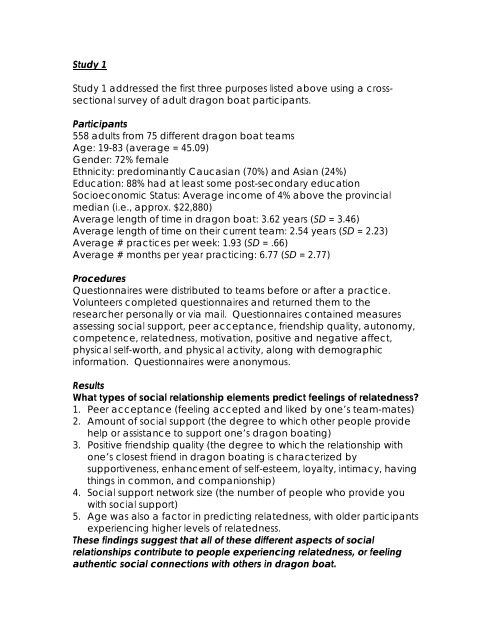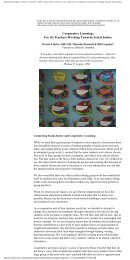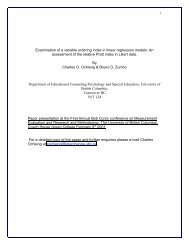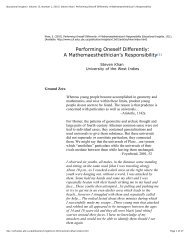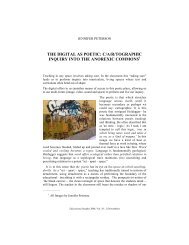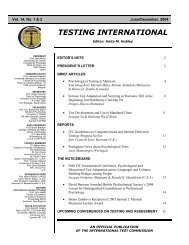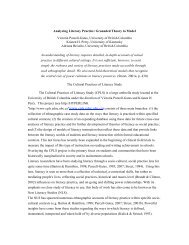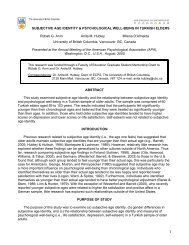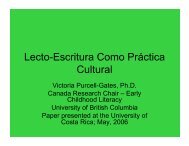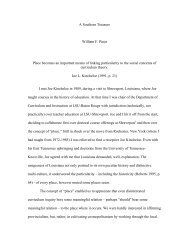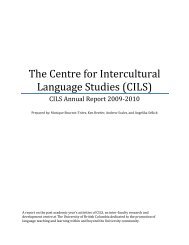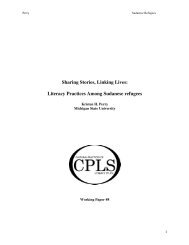The Role of Relatedness in Physical Activity Motivation, Behaviour ...
The Role of Relatedness in Physical Activity Motivation, Behaviour ...
The Role of Relatedness in Physical Activity Motivation, Behaviour ...
Create successful ePaper yourself
Turn your PDF publications into a flip-book with our unique Google optimized e-Paper software.
Study 1<br />
Study 1 addressed the first three purposes listed above us<strong>in</strong>g a crosssectional<br />
survey <strong>of</strong> adult dragon boat participants.<br />
Participants<br />
558 adults from 75 different dragon boat teams<br />
Age: 19-83 (average = 45.09)<br />
Gender: 72% female<br />
Ethnicity: predom<strong>in</strong>antly Caucasian (70%) and Asian (24%)<br />
Education: 88% had at least some post-secondary education<br />
Socioeconomic Status: Average <strong>in</strong>come <strong>of</strong> 4% above the prov<strong>in</strong>cial<br />
median (i.e., approx. $22,880)<br />
Average length <strong>of</strong> time <strong>in</strong> dragon boat: 3.62 years (SD = 3.46)<br />
Average length <strong>of</strong> time on their current team: 2.54 years (SD = 2.23)<br />
Average # practices per week: 1.93 (SD = .66)<br />
Average # months per year practic<strong>in</strong>g: 6.77 (SD = 2.77)<br />
Procedures<br />
Questionnaires were distributed to teams before or after a practice.<br />
Volunteers completed questionnaires and returned them to the<br />
researcher personally or via mail. Questionnaires conta<strong>in</strong>ed measures<br />
assess<strong>in</strong>g social support, peer acceptance, friendship quality, autonomy,<br />
competence, relatedness, motivation, positive and negative affect,<br />
physical self-worth, and physical activity, along with demographic<br />
<strong>in</strong>formation. Questionnaires were anonymous.<br />
Results<br />
What types <strong>of</strong> social relationship elements predict feel<strong>in</strong>gs <strong>of</strong> relatedness?<br />
1. Peer acceptance (feel<strong>in</strong>g accepted and liked by one’s team-mates)<br />
2. Amount <strong>of</strong> social support (the degree to which other people provide<br />
help or assistance to support one’s dragon boat<strong>in</strong>g)<br />
3. Positive friendship quality (the degree to which the relationship with<br />
one’s closest friend <strong>in</strong> dragon boat<strong>in</strong>g is characterized by<br />
supportiveness, enhancement <strong>of</strong> self-esteem, loyalty, <strong>in</strong>timacy, hav<strong>in</strong>g<br />
th<strong>in</strong>gs <strong>in</strong> common, and companionship)<br />
4. Social support network size (the number <strong>of</strong> people who provide you<br />
with social support)<br />
5. Age was also a factor <strong>in</strong> predict<strong>in</strong>g relatedness, with older participants<br />
experienc<strong>in</strong>g higher levels <strong>of</strong> relatedness.<br />
<strong>The</strong>se f<strong>in</strong>d<strong>in</strong>gs suggest that all <strong>of</strong> these different aspects <strong>of</strong> social<br />
relationships contribute to people experienc<strong>in</strong>g relatedness, or feel<strong>in</strong>g<br />
authentic social connections with others <strong>in</strong> dragon boat.


